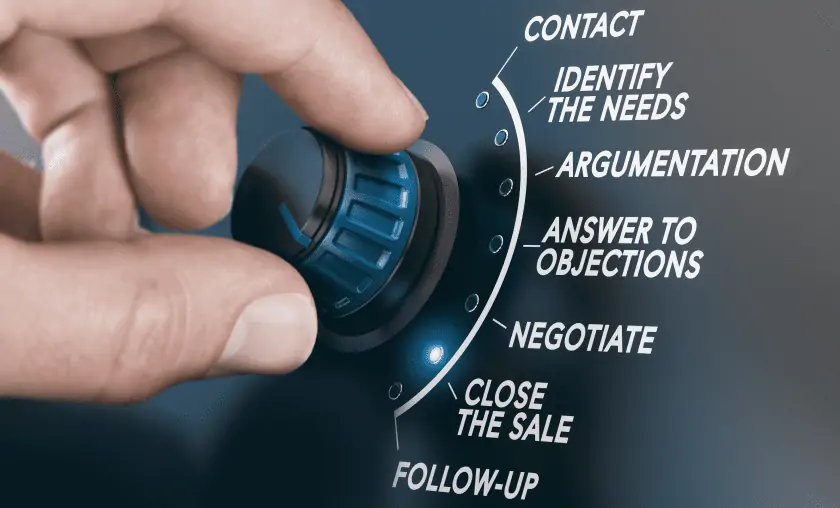If you’re not sure how to go about selling your product or service, it can feel like your business is just spinning its wheels—and that’s not good for anyone. The selling process helps you define and refine the way you sell so that you can create repeatable success and grow your business.
This article will show you a 7-step sales process that can help set you up for success.
What Is the Sales Process?
A selling process is a series of steps you take to convince a prospect to buy your product or service. It starts with identifying your target audience and figuring out their needs, then continues through creating a sales pitch, and finally ends with closing the deal.
A selling process helps:
- Make sure you’re not wasting time talking to the wrong people.
- Help you understand what your prospect needs so you can match them to your product or service.
- Give you a structured way of talking about your product or service so that it’s easier for people to understand and relate to.
When you have an established selling process, it’s much easier to stay focused on what matters most to closing a deal and helping customers solve their problems.
7 Steps in a Sales Process
1. Prospecting
Prospecting is the first step in the sales process. You should always look for new business opportunities and leads, but don’t expect every lead to be a good fit for your company. It’s best to focus on reaching out to prospects that are more likely to be interested in what you’re offering them. This can involve researching the industry and finding companies that are similar to yours, looking at their website and social media pages, or checking out their LinkedIn profiles.
2. Qualification
Once a prospect has been found, it’s essential to determine if they’re a good fit for your company’s products or services. This can be done by asking questions during the initial meeting with a client or requesting information from them.
3. Presentation
If the prospect has successfully qualified and seems interested in working with you, it’s time for a presentation. This is where you show off everything about your product or service. In doing that, make sure your prospect understands how your product or service will meet their needs, why it’s superior to other options on the market, and how much it costs.
4. Negotiation
In this step, you discuss pricing and payment terms with your potential buyer and convince them to purchase. This can be done through various strategies, but one of the most effective is to offer them a discount or special deal on the price. For example, if you’re selling high-ticket items, such as an electronic device, you may want to offer a higher discount.
Another negotiation strategy is by offering additional perks or benefits with the sale. For example, if someone is buying a car from you, they may feel more satisfied with their purchase if they can also get free car maintenance during the first year of ownership.
5. Closing the Sale
The goal of this step is to ask the client to say yes. It usually involves:
- Confirming all of their questions have been answered
- Restating any important details of the agreement
- Gaining commitment from them that they are satisfied with what they’ve agreed to purchase (and agreeing on payment)
6. Delivery/Implementation
Once the client has signed the contract, it’s time for you to deliver what you promised. Ensure all activities are done correctly and in a timely manner. The goal is to make your client delighted with their onboarding experience. If something goes wrong, resolve it immediately, so it doesn’t feel like a roadblock in the long run.
7. Follow-up
The final step in the sales process is follow-up. Doing it right will help you maintain a relationship with your customer, build trust, and show that you care about the customer’s satisfaction.
It’s also a great time to ask for referrals! If your customers are happy with your business, they will be more than happy to let others know about it.
Sales Process Tips: What is Important in the Selling Process?
It’s one thing to have a sales process; doing it right is another. You need to be strategic in each step to get the optimal outcome.
Here are some tips you should consider:
- Learn your product or service inside out. An excellent salesperson always understands what they’re selling and believes in it.
- Do your homework. Research your prospect as much as you can before talking to them.
- Make sure your pitch is professional and concise. The first impression counts.
- Don’t forget to ask questions! A good salesperson knows how to listen and ask questions to understand their client’s needs better.
Sales Process in B2B and B2C
When you’re selling to businesses (B2B), the sales process can be more complicated than when selling to consumers (B2C). The reason is that more people are usually involved in the decision-making process. A company will have a CEO, CFO, and maybe even an executive team who all have to agree on a purchase before it happens. That means it takes longer for a deal to be closed than for someone to decide to buy something from you as an individual consumer.
Salesforce Sales Process
Salesforce is a customer relationship management (CRM) tool that helps you manage your sales pipeline, track activity, and automate processes. Salesforce’s sales process is one of its biggest strengths, as it allows you to create custom workflows for each sales funnel stage.
The Salesforce sales process consists of standard objects like Leads, Accounts, Contacts, and Opportunities. It’s handled by the Sales Cloud, which helps you organize your sales opportunities in one place. You can use it to manage the entire sales process—from lead generation to order fulfillment.
How to Improve Your Selling Process?
One of the most important ways to improve your selling process is to get a better understanding of what your customers want. This can be achieved by using a revenue intelligence platform like Revenue Grid.
Revenue Grid allows you to capture and analyze every lead, opportunity, and deal in one place, so you can see exactly where your business is seeing success, where it’s falling short, and what changes need to be made. By collecting real-time insights into your sales performance, you can adapt your sales strategies quickly and maximize every opportunity.
With Revenue Grid, you can also understand your customers’ buying behavior and make decisions based on data rather than guesswork. You’ll know where your customers are coming from, how much they’re spending on your product or service, and what price point works best for them.
Create Your Sales Process Today
The selling process is one of the most critical parts of your business — it can make or break your success. The sooner you develop this process, the better it is for your sales team’s productivity and your business’s sales performance.
Ready to take action?
Create your sales process with Revenue Grid



